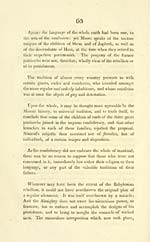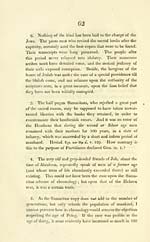Blair Collection > Celtic researches, on the origin, traditions & language, of the ancient Britons
(151)
Download files
Complete book:
Individual page:
Thumbnail gallery: Grid view | List view

01
îîiust have been fully adequate to the pui-pose for which it
was intended. It must have operated, as an effetìual cor-
redion, or as a signal punishment, whieli disposed the remains
of the human race to comply with the Divine decree.
Chronology has not expressly marked the aira of Nimrod's
rebellion, or of the dispersion of his adherents. But as tlie
immediate objeft of the former was to prevent the executioa
of a decree, which appears to have been published at the time
of the birth of Peleg, we may conclude that it took place soon
after that event. Nimrod might now be 60 or öö years old,
about the same age as Salah, his parallel in descent. If so,
he wacs, not in early youtli, but in tlie prime of niiinhood. —
For though the patriarchal age w as hitherto of great extent,
yet it appears that men soon came to maturity. In the first
century after the deluge, they married and had children,
generall3' about the age of thirty.
The Samaritan copy regularly adds 100 years to the age of
the patriarchs both before and after the flood, at the birth oi'
their sons ; so that the birth of Peleg is removed to about 400
years after the deluge. IMany learned men adopt this chro-
nology, because it allows time for an increase of populatiou
suitable to the great events of his time.
]May I offer a few remarks on this subjeiTt?
1 . Down to the death of Noah, Moses regularly gives the
age of the father, at the birth of such a sou, he adds the
remaining years of his liie, and then sums up the whole. —
The constant chauge of this enumeration cannot have hap-
pened through the mere inadvertency of transcribers. Some
wilful and systematical corruption must be supposed^ either iii
the Hebrew or Samiiritau text.
îîiust have been fully adequate to the pui-pose for which it
was intended. It must have operated, as an effetìual cor-
redion, or as a signal punishment, whieli disposed the remains
of the human race to comply with the Divine decree.
Chronology has not expressly marked the aira of Nimrod's
rebellion, or of the dispersion of his adherents. But as tlie
immediate objeft of the former was to prevent the executioa
of a decree, which appears to have been published at the time
of the birth of Peleg, we may conclude that it took place soon
after that event. Nimrod might now be 60 or öö years old,
about the same age as Salah, his parallel in descent. If so,
he wacs, not in early youtli, but in tlie prime of niiinhood. —
For though the patriarchal age w as hitherto of great extent,
yet it appears that men soon came to maturity. In the first
century after the deluge, they married and had children,
generall3' about the age of thirty.
The Samaritan copy regularly adds 100 years to the age of
the patriarchs both before and after the flood, at the birth oi'
their sons ; so that the birth of Peleg is removed to about 400
years after the deluge. IMany learned men adopt this chro-
nology, because it allows time for an increase of populatiou
suitable to the great events of his time.
]May I offer a few remarks on this subjeiTt?
1 . Down to the death of Noah, Moses regularly gives the
age of the father, at the birth of such a sou, he adds the
remaining years of his liie, and then sums up the whole. —
The constant chauge of this enumeration cannot have hap-
pened through the mere inadvertency of transcribers. Some
wilful and systematical corruption must be supposed^ either iii
the Hebrew or Samiiritau text.
Set display mode to: Large image | Transcription
Images and transcriptions on this page, including medium image downloads, may be used under the Creative Commons Attribution 4.0 International Licence unless otherwise stated. ![]()
| Early Gaelic Book Collections > Blair Collection > Celtic researches, on the origin, traditions & language, of the ancient Britons > (151) |
|---|
| Permanent URL | https://digital.nls.uk/75765541 |
|---|
| Description | A selection of books from a collection of more than 500 titles, mostly on religious and literary topics. Also includes some material dealing with other Celtic languages and societies. Collection created towards the end of the 19th century by Lady Evelyn Stewart Murray. |
|---|
| Description | Selected items from five 'Special and Named Printed Collections'. Includes books in Gaelic and other Celtic languages, works about the Gaels, their languages, literature, culture and history. |
|---|

